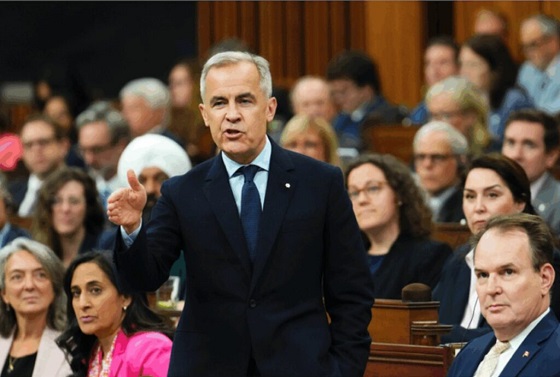Alberta
Nutrien may slow potash ramp-up plans as earnings, sales down

CALGARY — The CEO of Canadian fertilizer giant Nutrien Ltd. said Thursday the company may consider slowing down its previously announced plan to ramp up potash production, in light of falling prices and lower sales volumes.
The comments come as the Saskatoon-based company — the world’s largest fertilizer producer — lowered its earnings guidance for the year to between $6.4 billion and $8.0 billion, down from a previously announced range of $8.4 billion to $10 billion.
The company’s net earnings for the third quarter were US$576 million, down 58 per cent from US$1.4 billion a year earlier, and its sales for the quarter ended March 31 were US$6.1 billion, down 20 per cent from US$7.7 billion a year earlier.
“Yes, we would consider slowing down. We’re really, as we talked about earlier this year, watching the market,” CEO Ken Seitz told analysts on a conference call to discuss the company’s disappointing first-quarter financial results.
“If we see that the market’s not there, then we’ll pace our capital accordingly.”
It has been a volatile period for Nutrien, which achieved record earnings in 2021 and then saw fertilizer prices spike in March of 2022 as the Russia-Ukraine war shook up global agricultural markets and reduced supplies of fertilizer from Eastern Europe.
To meet increased global demand, Nutrien announced in June of last year a plan to ramp up potash production by 40 per cent compared with 2020 production levels — an increase of more than five million tonnes.
The company said it would achieve this by investing in expansions at its existing Saskatchewan mines, including the hiring of approximately 350 people.
But by the second half of 2022, Nutrien had suffered what it called a “historic” decline in the pace of its potash shipments. In North America and Brazil in particular, farmers appeared to be postponing fertilizer purchases in the face of high prices.
As a result, in February of this year, the company announced it would slightly delay its expansion plans, targeting 2026 instead of 2025 to reach its potash production target of 18 million tonnes.
While Seitz said Thursday the company is open to slowing its plans further, he said he remains bullish on the longer-term outlook for fertilizer. He said Nutrien anticipates increased global potash demand in the second half of the year as a result of lower-than-expected inventories and improved affordability for farmers compared with 2022.
He added that historically, periods of lower-than-normal demand have been followed by years of strong demand growth — and he expects that to happen again.
“The reality is again that we are in a market that’s growing,” Seitz said.
“We believe that’s going to carry on for the absolute foreseeable future — a two and a half to three per cent annual growth rate. New supply’s going to be required to meet that growing demand.”
Nutrien’s share price tumbled Thursday on the company’s first-quarter results, trading down almost five per cent on the Toronto Stock Exchange as of mid-day.
The company’s diluted net earnings per share for the quarter were US$1.14, down 54 per cent from US$2.49 a year earlier.
This report by The Canadian Press was first published May 11, 2023.
Companies in this story: (TSX:NTR)
Amanda Stephenson, The Canadian Press
Alberta
Danielle Smith slams Skate Canada for stopping events in Alberta over ban on men in women’s sports

From LifeSiteNews
The Alberta premier has denounced Skate Canada as ‘disgraceful’ for refusing to host events in the province because of a ban on ‘transgender’ men in women’s sports.
Alberta Premier Danielle Smith has demanded an apology after Skate Canada refused to continue holding events in Alberta.
In a December 16 post on X, Smith denounced Skate Canada’s recent decision to stop holding competitions in Alberta due to a provincial law keeping gender-confused men from competing in women’s sports.
“Women and girls have the right to play competitive sports in a safe and fair environment against other biological females,” Smith declared. “This view is held by a vast majority of Albertans and Canadians. It is also common sense and common decency.”
Women and girls have the right to play competitive sports in a safe and fair environment against other biological females.
This view is held by a vast majority of Albertans and Canadians. It is also common sense and common decency.
Skate Canada‘s refusal to hold events in… pic.twitter.com/n4vbkTx6B0
— Danielle Smith (@ABDanielleSmith) December 16, 2025
“Skate Canada‘s refusal to hold events in Alberta because we choose to protect women and girls in sport is disgraceful,” she declared.
“We expect they will apologize and adjust their policies once they realize they are not only compromising the fairness and safety of their athletes, but are also offside with the international community, including the International Olympic Committee, which is moving in the same direction as Alberta,” Smith continued.
Earlier this week, Skate Canada announced their decision in a statement to CBC News, saying, “Following a careful assessment of Alberta’s Fairness and Safety in Sport Act, Skate Canada has determined that we are unable to host events in the province while maintaining our national standards for safe and inclusive sport.”
Under Alberta’s Fairness and Safety in Sport Act, passed last December, biological men who claim to be women are prevented from competing in women’s sports.
Notably, Skate Canada’s statement failed to address safety and fairness concerns for women who are forced to compete against stronger, and sometimes violent, male competitors who claim to be women.
Under their 2023 policy, Skate Canada states “skaters in domestic events sanctioned by Skate Canada who identify as trans are able to participate in the gender category in which they identify.”
While Skate Canada maintains that gender-confused men should compete against women, the International Olympic Committee is reportedly moving to ban gender-confused men from women’s Olympic sports.
The move comes after studies have repeatedly revealed what almost everyone already knew was true, namely that males have a considerable innate advantage over women in athletics.
Indeed, a recent study published in Sports Medicine found that a year of “transgender” hormone drugs results in “very modest changes” in the inherent strength advantages of men.
Additionally, male athletes competing in women’s sports are known to be violent, especially toward female athletes who oppose their dominance in women’s sports.
Last August, Albertan male powerlifter “Anne” Andres was suspended for six months after a slew of death threats and harassments against his female competitors.
In February, Andres ranted about why men should be able to compete in women’s competitions, calling for “the Ontario lifter” who opposes this, apparently referring to powerlifter April Hutchinson, to “die painfully.”
Interestingly, while Andres was suspended for six months for issuing death threats, Hutchinson was suspended for two years after publicly condemning him for stealing victories from women and then mocking his female competitors on social media. Her suspension was later reduced to a year.
Alberta
Alberta’s huge oil sands reserves dwarf U.S. shale

From the Canadian Energy Centre
By Will Gibson
Oil sands could maintain current production rates for more than 140 years
Investor interest in Canadian oil producers, primarily in the Alberta oil sands, has picked up, and not only because of expanded export capacity from the Trans Mountain pipeline.
Enverus Intelligence Research says the real draw — and a major factor behind oil sands equities outperforming U.S. peers by about 40 per cent since January 2024 — is the resource Trans Mountain helps unlock.
Alberta’s oil sands contain 167 billion barrels of reserves, nearly four times the volume in the United States.
Today’s oil sands operators hold more than twice the available high-quality resources compared to U.S. shale producers, Enverus reports.
“It’s a huge number — 167 billion barrels — when Alberta only produces about three million barrels a day right now,” said Mike Verney, executive vice-president at McDaniel & Associates, which earlier this year updated the province’s oil and gas reserves on behalf of the Alberta Energy Regulator.
Already fourth in the world, the assessment found Alberta’s oil reserves increased by seven billion barrels.
Verney said the rise in reserves despite record production is in part a result of improved processes and technology.
“Oil sands companies can produce for decades at the same economic threshold as they do today. That’s a great place to be,” said Michael Berger, a senior analyst with Enverus.
BMO Capital Markets estimates that Alberta’s oil sands reserves could maintain current production rates for more than 140 years.
The long-term picture looks different south of the border.
The U.S. Energy Information Administration projects that American production will peak before 2030 and enter a long period of decline.
Having a lasting stable source of supply is important as world oil demand is expected to remain strong for decades to come.
This is particularly true in Asia, the target market for oil exports off Canada’s West Coast.
The International Energy Agency (IEA) projects oil demand in the Asia-Pacific region will go from 35 million barrels per day in 2024 to 41 million barrels per day in 2050.
The growing appeal of Alberta oil in Asian markets shows up not only in expanded Trans Mountain shipments, but also in Canadian crude being “re-exported” from U.S. Gulf Coast terminals.
According to RBN Energy, Asian buyers – primarily in China – are now the main non-U.S. buyers from Trans Mountain, while India dominates purchases of re-exports from the U.S. Gulf Coast. .
BMO said the oil sands offers advantages both in steady supply and lower overall environmental impacts.
“Not only is the resulting stability ideally suited to backfill anticipated declines in world oil supply, but the long-term physical footprint may also be meaningfully lower given large-scale concentrated emissions, high water recycling rates and low well declines,” BMO analysts said.
-

 Daily Caller1 day ago
Daily Caller1 day agoParis Climate Deal Now Decade-Old Disaster
-

 armed forces2 days ago
armed forces2 days agoOttawa’s Newly Released Defence Plan Crosses a Dangerous Line
-

 Indigenous1 day ago
Indigenous1 day agoResidential school burials controversy continues to fuel wave of church arsons, new data suggests
-

 Alberta1 day ago
Alberta1 day agoAlberta’s huge oil sands reserves dwarf U.S. shale
-

 Business21 hours ago
Business21 hours agoOttawa Pretends To Pivot But Keeps Spending Like Trudeau
-

 Energy21 hours ago
Energy21 hours agoLiberals Twisted Themselves Into Pretzels Over Their Own Pipeline MOU
-

 Censorship Industrial Complex19 hours ago
Censorship Industrial Complex19 hours agoHow Wikipedia Got Captured: Leftist Editors & Foreign Influence On Internet’s Biggest Source of Info
-

 Health2 days ago
Health2 days agoCanadian gov’t considers sharing census data on gender-confused children









